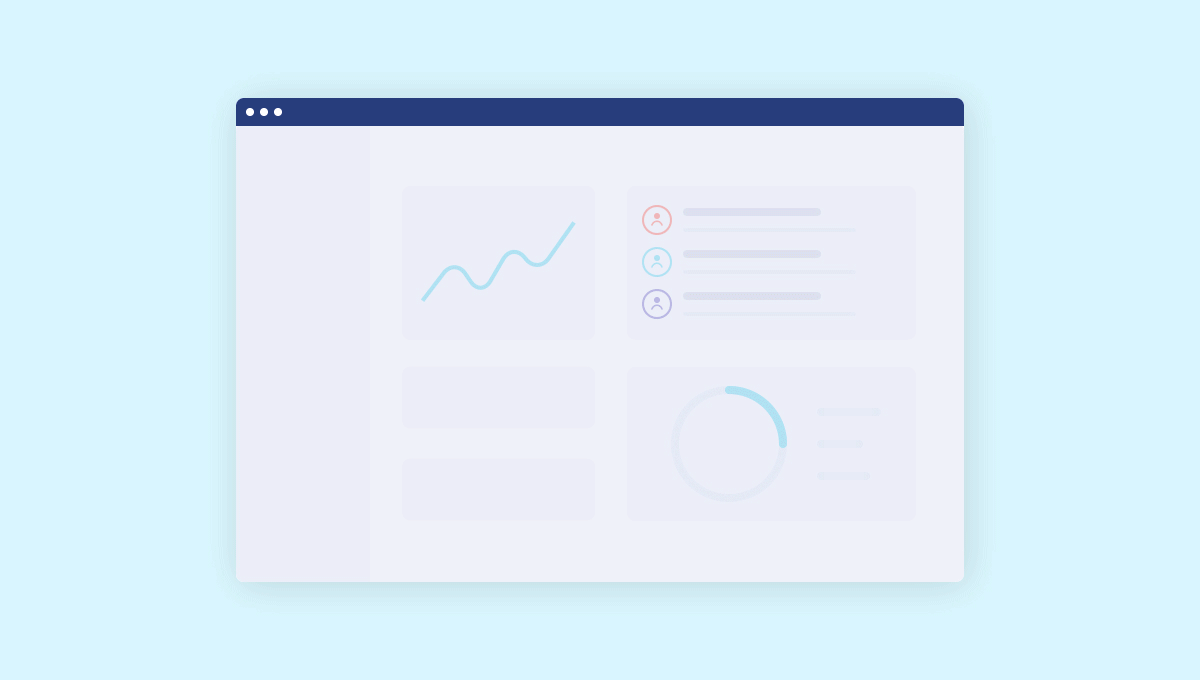Signing up new users is exciting. It shows that people are interested in your product and believe it can help them achieve their goals.
But getting people to try out your product is only half the battle. Many companies struggle to convert trial sign-ups into long-term customers.
In this post, we examine the 4 user adoption metrics you should be tracking to make quick and informed decisions to turbocharge your product adoption.
They’ll help you be present at every step of the user’s journey and ensure you’re delivering consistent value.
Looking for easy-to-use onboarding software for your company?
Stonly helps make user adoption hassle-free for your users
Start FREE Trial
Why is measuring user adoption important?
To improve customer experience and increase conversion rates, you must understand user behavior towards different features and services to identify where you’re adding value.
Engagement metrics can tell you how much time a user spends on your product, while overall adoption metrics provide usage and sales numbers. But these metrics aren’t enough to explain why some users turn into loyal customers while others leave soon after sign-up without even trying out the main features.
To know this, you need to collect metrics that give you in-depth data about the product experience and tell you which specific features and services they engaged with.
How to measure the success of your user adoption strategy
To measure the success of your SaaS user adoption strategy, you need to understand how much value your users are getting from your product.
By tracking the right metrics, you’ll gain valuable insights into which parts of the SaaS adoption curve are working and which ones you need to improve. When you have reliable data about user adoption, you can make significant improvements to your product that will grow your business.
4 user adoption metrics you should be tracking
The user adoption metrics that you choose to track will depend on your focus, and whether you are coming from a sales, marketing or product development perspective.
Depending on what’s essential to your business and what needles you’re trying to move, you want to focus on one or all of the metrics described below:
Activation
Activation happens when a user sees the promised value they originally signed up for.
It’s an important milestone in the user journey. From this point on, your users fully engage with the product and have activated its key features. And most importantly, they’ve upgraded from a free trial to the premium version.
But how can you measure user activation? What metrics can you track to understand what transforms a free trial user into an activated user, and how can you replicate this experience to get even more activated users upgrading to the paid-for product?
To begin measuring user activation, you need to know what to measure to see if a user:
- Is getting started?
- Is starting to become successful?
- Has become successful? This is your activation metric. For example, for a scheduling app like Calendly, this metric could be five meetings scheduled in the first seven days.
To calculate the activation rate for your product, define the actions users need to take to experience value and become regular users. This will depend on your business.
For example, for Stonly an activated user is one that created a guide and made 20 edits. But for Slack, an activated user is a company that hits the thousand message mark.
To calculate your activation rate, divide users who have reached the activation milestone by the number who signed up. Then, multiply by 100.
First key action
A first key action is a helpful metric for seeing how quickly new users are adopting your product. First key actions look different for every product. For Stonly, the first key action could be creating a guide, while for Slack, it might be responding to a message or starting a channel.
There are two ways to turn a first key action into a usable metric. You can look at the time it takes for different users to make the first key action. Add the combined amount of time and divide by the number of users, to get the average time.
You can also measure the percentage of users who perform a key action for the first time out of the total number of new signups to your product.
Improving activation rates
The best way to improve your user activation rates is to create a seamless and painless onboarding experience that will show users your product’s value during their first steps.
Stonly offers interactive onboarding, helping users adjust more easily and keeping them engaged. You can customize Stonly’s tools to the customer journey to help new users feel comfortable. This can help:
- Get a head-start with user adoption
- Keep users in the loop
- Avoid possible confusion with new features
- Help users seamlessly revisit more complicated processes

You can also use a welcome screen and onboarding checklists to make sure the journey is as smooth as possible.
Stickiness
Intensity, commonly known as product stickiness, measures how often people return to your product.
The ideal intensity rate varies for different SaaS products. While some products (e.g. messaging apps) are for daily use, others, like e-commerce sites, only require a return rate of a few times a week or month.
Three main metrics for measuring intensity are:
1. Daily Active Users (DAU)
These are your active users during a specific day. Since daily usage figures can vary so much, this figure is more useful when compared with weekly or monthly use to see your product's impact and usage.
2. Monthly Active Users (MAU)
This is the number of unique active users, both new and returning, during any 30-day period.
3. Weekly Active Users (WAU)
This is the number of users that have been active at least once over a seven-day period on your platform.
Most online businesses keep close track of their DAU, MAU and WAU figures to show their intensity rate.
Intensity is generally calculated as the ratio of Daily Active Users to Monthly Active Users. A DAU/MAU ratio of 50% would mean that the average user of your product is using it 15 out of 30 days that month.
Improving intensity rates
To improve your intensity rates, it’s essential to discover which aspects of your product are bringing users back to your site. This will give you insight into how you can tweak the onboarding journey to show new users the value of your product quickly:
To do this, you can:
- Interview successful users to understand what's working for them
- Analyze emails and in-app messages to find out what makes similar users successful
- Adjust the onboarding process to make new users aware of the features favored by successful users.
- Run A/B tests to trial a new onboarding process to see if it’s more successful at converting users
With Stonly, you can gradually present new users with information as they get to know the tool. Throughout their journey, you can remind them how to use certain features, offer guidance and give them the chance to provide you with feedback.

You'll be able to create a clear map of a successful user’s journey and offer ongoing support to your customers.
Looking for easy-to-use onboarding software for your company?
Stonly helps make user adoption hassle-free for your users
Start FREE Trial
Depth of usage
While activation and stickiness metrics tell you about your product’s breadth of usage, you can use depth of usage metrics to take your data to another level. Not only will you know how many users you have, but you’ll also find out how long they spend using specific product features and add-ons.
This makes depth of usage one of the most critical metrics for user retention. Your most successful users will show you which features and integrations they prefer and how they use them. Using this feedback can make your product more attractive to new users.
To measure the depth of usage, look at the Minutes per MAU ratio. How much time is spent on average per user?
If your MAU number is rising, but the time they spend with a specific feature or generally using your tool is dropping, you’ll likely see a rise in churn.
Product usage depth
Product depth usage represents the amount of time users spend with your SaaS product. To better understand this, look at metrics like:
- How long are customers using the main feature?
- What is the average time spent with your tool?
- How much time are they spending on individual features?
- How much time are they spending on new features?
Add-ons
Similar to product usage depth, you also want to see how much time people spend using add-ons such as integrations.
To calculate this, use the same metrics listed for product depth usage. You can also get customer feedback to see how valuable an add-on is to them and if you should add more. This way, you will better grasp how to add value to the customer experience with your tool.
Improving depth of usage
Lack of depth can be caused by a lack of user understanding. If users are confused about how new features work or how these features can enhance their experience, they’ll spend less time with your product.
A good way of improving your depth of usage is to show users how integrations and product features can add value to their journey.
Once you understand what makes similar users successful, you can use Stonly to help you improve your product's depth of usage.
The Stonly widget can help prompt users to try out new features or integrations, while Stonly interactive guides can give them the support they need when needed.
You can also use Stonly’s on-demand messaging app to support users in real time. Also, Stonly’s pathway insight can tell where users are getting stuck, so you don’t have to rely on them telling you themselves.
User retention
User retention is the number of customers who remain after signup. Essentially, it represents the loyal users who didn’t leave or churn.
Let’s take a closer look at both churn and retention metrics.
Churn
Users churn when they are disengaged and don’t see the value they were hoping for on sign-up.
You can never achieve zero churn, but you can lower churn to a point where your revenue is unaffected.
There are two types of churn to consider: user churn and revenue churn.
User churn refers to the number of customers you lose over a given time, while revenue churn is the amount of money up for renewal you lose over a given period.
Both metrics are equally important. If user churn is higher than revenue churn, you’re losing users with lower usage of your tool. If it is the opposite, you may be losing valuable customers but gaining new, less valuable ones.
To calculate user churn, divide the number of customers lost in a timeframe by the starting number of users, and multiply it by 100. After that, identify when a user started to churn and how long it took. This helps specify the metric and identify actions you can take to retain them.
If your churn rate goes up unexpectedly, ask questions like:
- Was a new feature rolled out?
- Did a much-valued feature go away?
- Did prices go up?
Use in-app activity tracking to see what features your customers are using. Also, determine if they opened your welcome email or completed onboarding correctly, as these factors can affect overall churn.
Retention
Understanding your retention rate will give you a clear view of user adoption. It’s a fundamental metric for SaaS subscription models, like pay for TV or news services, to determine whether customers keep using your product month after month.
To calculate the retention rate, use the same formula that you used for churn. So, divide the number of users in a timeframe by the starting number of users and then multiply by 100.
For subscription models, you can look at the number of renewed subscriptions monthly.
Improving user retention
To improve retention and reduce churn, you can use in-app surveys to understand why users are disengaged. When you know the reason they are leaving, you can offer temporary incentives, such as pausing payments while you make improvements.
This way, you increase your customer’s lifetime value by providing valuable products and solutions to loyal users.
Stonly offers NPS surveys which can help point to the causes of churn. User feedback is the primary step toward reducing churn. Stonly’s surveys and questionnaires make it easy to understand the user journey in real time. You will know:
- How users are reacting to a new feature
- What they want to achieve with a tool
- Why they are thinking about giving up on your product
- How well product adoption is going
- How successful the onboarding experience was
How can you improve the user adoption metrics for your product?
When you can accurately measure user adoption metrics, you’ll be able to spot problem areas and make quick, informed decisions to drive higher user adoption.
Stonly offers a tailored user adoption solution that will give you the insights you need to achieve your user adoption goals.
You’ll get the tools you need to understand your software product adoption rates and find out:
- How users are engaging
- Where they’re getting stuck (Stonly customer pathway insights)
- How you can improve your product
Activation rates drop sharply after the first key action, so don’t underestimate the importance of a great onboarding experience. This will help you nurture loyal customers and drive up retention rates.
With Stonly you can offer smooth onboarding and troubleshooting, thanks to features such as:
- On-demand guides
- Tailored, interactive walkthroughs
- Customer help center
- Pop-up widgets
- In-app help
To ensure user retention, you can communicate at relevant times with users in-app via nudges and push notifications. You can also collect their feedback with in-app surveys to better understand your lifetime customer value.
Looking for easy-to-use onboarding software for your company?
Stonly helps make user adoption hassle-free for your users
Start FREE Trial
Make the most of user adoption metrics
By tracking a mix of user adoption metrics that go beyond the usual engagement figures and user numbers, you’ll get a deep understanding of how your users are reacting to your product, what they want, and what you can change.
Having a user adoption strategy that relies on metrics rather than guesswork will also help you implement software adoption best practices.
At the same time, a smooth onboarding process that responds to customer feedback will help make your users aware of the value you deliver and improve retention rates.
With Stonly, you can achieve this through user insights, surveys, in-app guidance, and many other features developed to improve your product’s adoption rates.
Frequently asked questions about user adoption metrics and measurement
What is the difference between adoption and engagement metrics?
Adoption metrics tell you exactly how a customer uses your website or tool, for example, which unique features they use. Engagement metrics are less detailed and measure the time a user spends on your site, showing their level of interest.
How is user activity measured?
You can measure user activity by metrics including activation, intensity/stickiness, depth of use, and user retention. You can track the time a user spends on a product or feature, measure conversion rates, and purchases, and ask your users for feedback on your product.
How do you measure changes in adoption?
You can measure changes in adoption by implementing a user adoption strategy that collects metrics on activation, intensity/stickiness, depth of use, and user retention, as well as collecting insights from users.
What are retention metrics?
Retention metrics relate to churn and retention. They tell you how many users continue to use your tool and how many are leaving.
